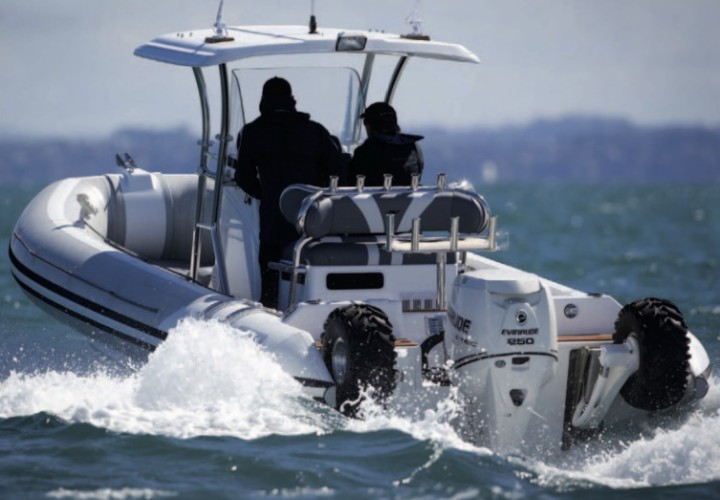Lady May, the latest Southstar 37 to be completed by Salthouse Boatbuilders from the Greenhithe yard in Auckland, runs a Hamilton jet drive, the first jet installation in a Southstar 37 and one that was done for the specific needs of the owners. Prior to this, of the five Southstar 37s built, three were Yanmar diesel shaft drive, one was a Volvo Penta diesel sterndrive, and one was powered by a V8 4-stroke petrol outboard – a very mixed range of engine options.
We thought it would be interesting to compare the four drive / engine packages to see what the differences were, not only in running costs, but performance and set-ups.
The four boat and engine packages are: Lady May (Yanmar 6LY3-ETP/Hamilton 292 Jet), Juno (Volvo Penta D6-400 Duoprop DPH), Windward (Yanmar 6LY2A-STP/shaft), and Southstar (Yamaha 350 V8 outboard).
The Boat
The 11.5m Southstar 37, built by Salthouse Boatbuilders Ltd, is a Nick Peal design that was first launched in 2006. Although the Southstar 37 has classic lines that capture the elegance of a previous era, it is every bit a modern boat from the construction and layout, to the performance.
Construction is conventional GRP, with the running surface traditional monohedron with constant deadrise over the aft planing sections, with a variable deadrise forward, rising to a fairly sharp entry bow. Deadrise at the transom is a moderate 13 degrees.
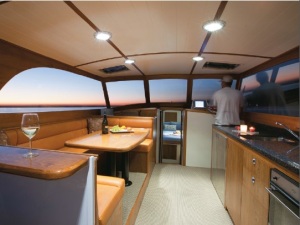
This is very much a semi-production custom boat so the layout can be tailored to suit each owner, although there seems to have been a fairly standard theme through all boats built so far. While the layout of the interior has been much the same, there are obvious ‘space gains’ from the outboard power option.
This really shows in the accommodation plan. With the diesel inboard option you have a double berth forward and two singles to starboard, whereas with the outboard you can fit two doubles plus the two singles in the two-cabin layout. If you opt for a couple of diesel stern drives, pods or even a V-drive single diesel as your choice of power then this same layout would also be possible.
In Juno, (Volvo Penta D6-400 DPH) and Lady May (Yanmar 6LY3-ETP/Hamilton 292) a 1.2m jackshaft was used so the engine was well forward of the transom, and in roughly the same position as the standard inboardon- shaft option. This served two purposes. Firstly, it meant the extra storage space in a large lazarette aft of the engine could be retained and secondly, the critical weight distribution and balance of the boat was not compromised.
However, you do still have the option of running the engine at the rear of the cockpit and whilst the engine box needs to be only 100mm high from the sole, it makes much better sense to make it 400mm high, so you can have an extra table/seat area. The forward space can then be converted to extra storage.
Also, any readjustment of the weight distribution in the boat can still easily be achieved. With the V8 Yamaha powered Southstar, the engine is forward of the exposed aft transom and mounted separately under its own enclosed engine box that covers the engine totally. Unless you open the hatch or ask, you would not know it was there. As outboards last longer when they breathe fresh air, a special air ducting system was installed, which after a few seasons of boating has proven to work exceptionally well.
Layout for Cruising
The layout of the Southstar 37 is very much about cruising. For’ard is the master cabin with a central island berth with storage in side shelves, under the berth and side lockers. The ceiling is all tongue and groove painted timber that is run throughout the boat.
The saloon is surrounded by high profile side windows and with the raised port side settee you get excellent all round visibility – great for sitting and watching what your neighbours in the bay are doing. Plenty of Hella LED flushmounted overhead lights keep the area well lit. The table also drops down to convert the area into an extra double berth.
The galley takes up most of the starboard side of the saloon and has an almost full-length composite bench top with the usual storage lockers and drawers beneath, plus an Isotherm fridge/freezer unit, two-burner gas powered stove and space for an under-bench oven. The forward steering station has also been kept as simple as possible, with minimal instrumentation, switches and electronics. Like the rest of the boat, this area is totally custom built to suit whatever a client wants.
In the diesel version the whole transom folds down to make the boarding platform. Obviously that’s not possible with the outboard version, but the plus side is that the engine box doubles as a great bench top when fishing, or as a table when eating outdoors. In all versions the cockpit sole is all teak and ample use is made of storage areas beneath.
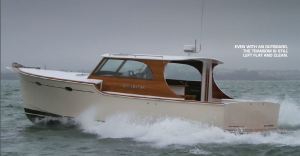
Differences
There is a 431kg weight difference between the outboard Yamaha V8 (354kg) and the Volvo Penta D6-400 DP (785kg). The Yanmar 6LY2A-STP engine only, is 535kg and the Yanmar 6LY3-ETP engine only is 640kg. The newer 6LY3-ETP is slightly heavier due to its being a 24-valve as opposed to the older 6LY2A-STP being a 12-valve engine, and the 6LY3 also has a cast flywheel and electronic components. When you then add on the Hamilton 292 jet unit at 190kg, the all-up weight of the drive train for the 6LY3-ETP is 830 kg.
An inboard Southstar 37 has a displacement around 7000kg, whereas the outboard powered Southstar is closer to 6000kg. However, while the composite GRP hulls and superstructures are identical, due to the differences in the masses and locations of the various engines, tankage and some standard equipment are differently located for optimal balance of the boat.
So what about cost, both in the initial purchase price (prices include GST) of the engine/drive packages, and in the overall price of the boat? By far the least expensive to buy is the Yamaha V8 outboard @ around $NZ50,000. It is also the quickest and easiest to install, taking only a few hours to bolt onto the transom. Plus, it can be as quickly removed if you ever want to replace it. It comes with a standard rigging kit which has options as required and includes digital control Lan instruments and looms.
The Volvo Penta D6-400 DPH has a retail price of around $NZ98,000 and is an all-in-one package, including electronic throttle controls, LCD dash display, power trim assist software, trip and fuel software and power steering. Plus, it comes with the heavy-duty Duoprop sterndrive and propellers. The two Yanmar engines price out at $NZ67,500 for the 6LY2A-STP and $NZ74,000 for the 6LY3-ETP. Overall prices vary depending on the gearbox option. In the case of the shaft drive 6LY2A-STP option you then need to take into account the extra cost of the drive train, and steering which will add somewhere around $NZ25,000 to the overall price. The Hamilton 292 added a further $NZ44,134 to
the price of the 6LY3-ETP package. Plus, in both the Duoprop and Hamilton jet installations there were the extra costs of custom made jackshafts.
Overall, if it’s a cost thing, then the outboard is by far the cheapest option, followed by the sterndrive, the jet and the shaft packages. As for running costs, especially when considering petrol to diesel, well that’s another story. While the outboard is cheaper to install it is not inexpensive to run when considering the cost of a litre of petrol. However this is more of an issue in New Zealand than Australia, where Aussies pay very little difference between the two different fuels.
The Engines
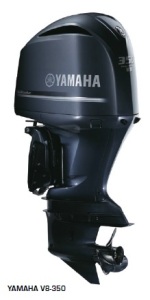
Yamaha V8
The company’s first V8 outboard powerhead design is a 60-degree V8 with 32 valves (four valves per cylinder) and double overhead cams. The world’s first V8 four-stroke outboard, the 5.3-litre F350 provides up to 45% more thrust than 250hp-class outboards. To handle the power of the F350, its drive train features hardened gears and high-strength, oversized bearings and bearing surfaces. It also features strong, forged motor mounts and an oversized bracket specifically designed to harness its power and thrust while minimising vibration and noise.
Yamaha has incorporated sacrificial anodes throughout the powerhead, mid-section and lower unit, minimising corrosion in vital engine components.
The F350 has combustion sensors that constantly monitor combustion conditions and adjust spark timing, and Yamaha’s Command Link digital electronic control system with redundant electronic engine control, to prevent engine knock.
The F350 is designed for the heaviest offshore outboard-powered boats.
www.yamaha-motors.com
Volvo Penta D6-400
Volvo Penta’s 6-cylinder D6-400 is developed from the latest design in modern diesel technology. The engine has a common rail fuel injection system, double overhead camshafts, four valves per cylinder, turbocharger, compressor, and aftercooler. The interaction of these and the EVC system results in exceptional diesel performance combined with low emissions.
The common rail fuel injection system, controlled by EVC, and the compressor, in combination with a large swept volume, ensure a relatively flat torque curve. The engine is lightweight and extremely compact for its large swept volume and high output. With the rear-end transmission driving the high-pressure injection pump and the camshafts, a high degree of integrated systems, a high-efficiency aftercooler, a marinisation performed with very few hoses, and engine dimensions fully symmetric about the centreline, make for a very compact package.
The common rail injection system in combination with electronics and an advanced combustion system are setting new standards in minimising noxious emissions and particulates. The engine complies with IMO NOx limits and the comprehensive emission requirements EU RCD and US EPA Tier 2.
The D6-400 is coupled to the heavy duty Duoprop DPH drive, which has been designed to lead exhaust gases into the propeller path and keep noise levels at a minimum.
www.volvopenta.com
Yanmar 6LY2A-STP
The release of the 6LY2A-STP increased the horsepower available in Yanmar’s 6LY series. It has a virtually square end profile of 709mm x 708mm for compactness. The mountability is excellent due to its flat top, its compact marine gear that has its bottom level with the
sump, and due to its narrow profile.
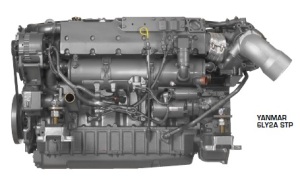
Direct injection using ultra-high-pressure fine-mist injectors provides excellent fuel economy and minimal smoke under hard use conditions. All service points are conveniently placed high on the engine.
The engine is a turbocharged, direct injected, intercooled, in-line 12-valve 6-cylinder displacing 5.813 litres to produce 440mhp (324kW) at 3300rpm. With a dry engine weight of only 535kg (excluding gearbox) the 6LY2A-STP has an excellent power-to-weight ratio.
The engine is compatible with the CAN-BUS network on NMEA 2000 open protocol. The 6LY2 has a mechanical governor and is a great choice for those who don’t want an electronically controlled engine and prefer a basic power plant.
www.powerequipment.co.nz
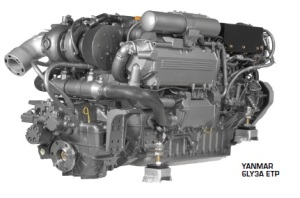
Yanmar 6LY3-ETP
The 480mhp (353kW) 6LY3-ETP, is a turbocharged, intercooled, waste-gated, directinjection, 24-valve, in-line-six engine with an electronic governing system. Its displacement is 5.813 litres. Exhaust emissions have been reduced significantly.
This electronic control offers constant power regulation – regardless of fuel temperatures up to 50ºC – and synchronises the engine speeds of twin installations. The electronic control manages the fuel delivery and injection timing of the high-pressure fuel pump, resulting in slightly more torque and improved fuel economy. Information from the electronic control system is shown on a multi-function Yanmar LCD display at the helm.
The engine weighs just 640kg (excluding gearbox), giving it an outstanding power-toweight ratio and making the 6LY3 series the most compact diesels in their class. Length is 1,300mm, width 801mm and height 777mm. This engine is fully compliant with EPA Tier 2, SAV/BSO Tier 2 excluding mass emission (for 6LY3-ETP), the 6LY3-STP & 6LY3-UTP models will be certified in due course, RCD and IMO requirements.
The 6LY3-ETP was fitted with a reversing reduction gearbox and coupled to a Hamilton 292 waterjet. Full steerage is always available regardless of reversing duct position i.e. regardless of speed or direction. By working reverse and steering in unison a resultant thrust can be obtained in any direction giving 360-degree manoeuvring.
www.powerequipment.co.nz
Summary
These results are more or less as expected – the sterndrive has the best fuel economy, and the outboard has the worst – even worse when factoring in the extra cost of petrol above diesel. The sterndrive, unexpectedly given that its power advantage over the outboard at the propeller shaft is only 27bhp or 8%, considerably outpaces the outboard and the other two options.
The power difference suggests that the sterndrive should have a speed advantage over the outboard of less than 4%, rather than the measured 22%. However, prospective owners should perhaps put an accountant’s cap on and carefully consider the very much lower initial finished cost of the outboard-powered boat, and balance that against the fuel cost for their expected annual use.
In addition, although noise levels were not measured, chances are that the enclosed outboard is much quieter, has a much less smelly exhaust than any of the diesels, and also sends much less vibration into the boat. The outboard also tilts completely above the bottom of the boat, unlike the sterndrive and the shaft drive.


